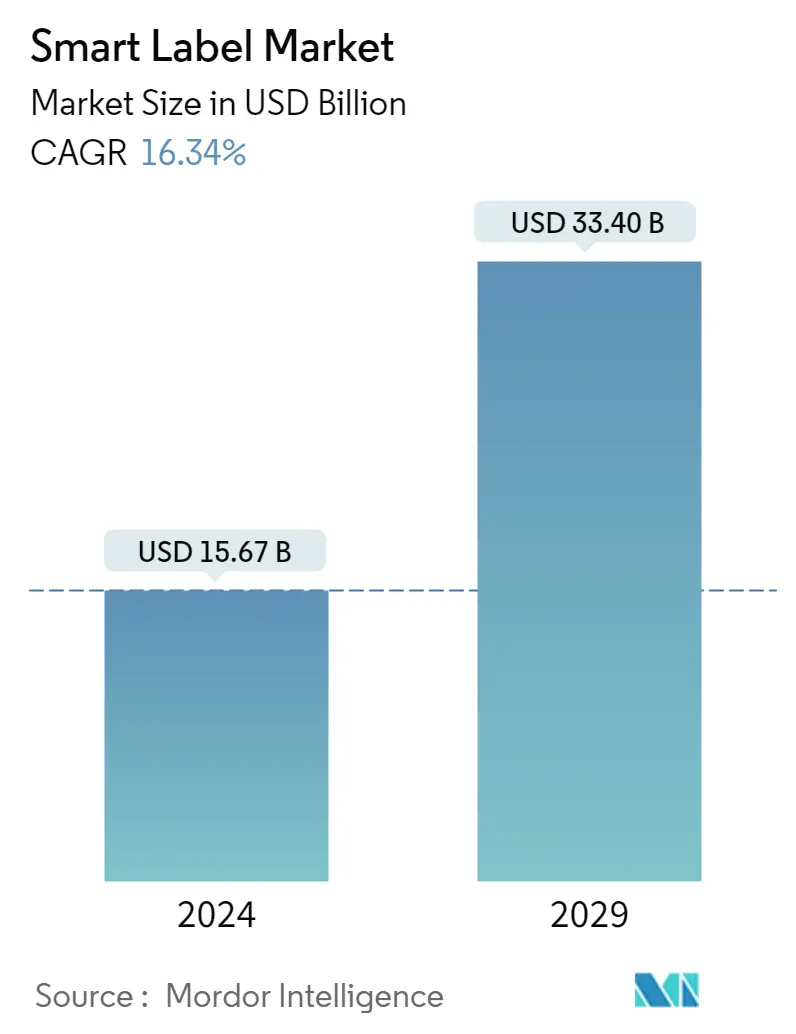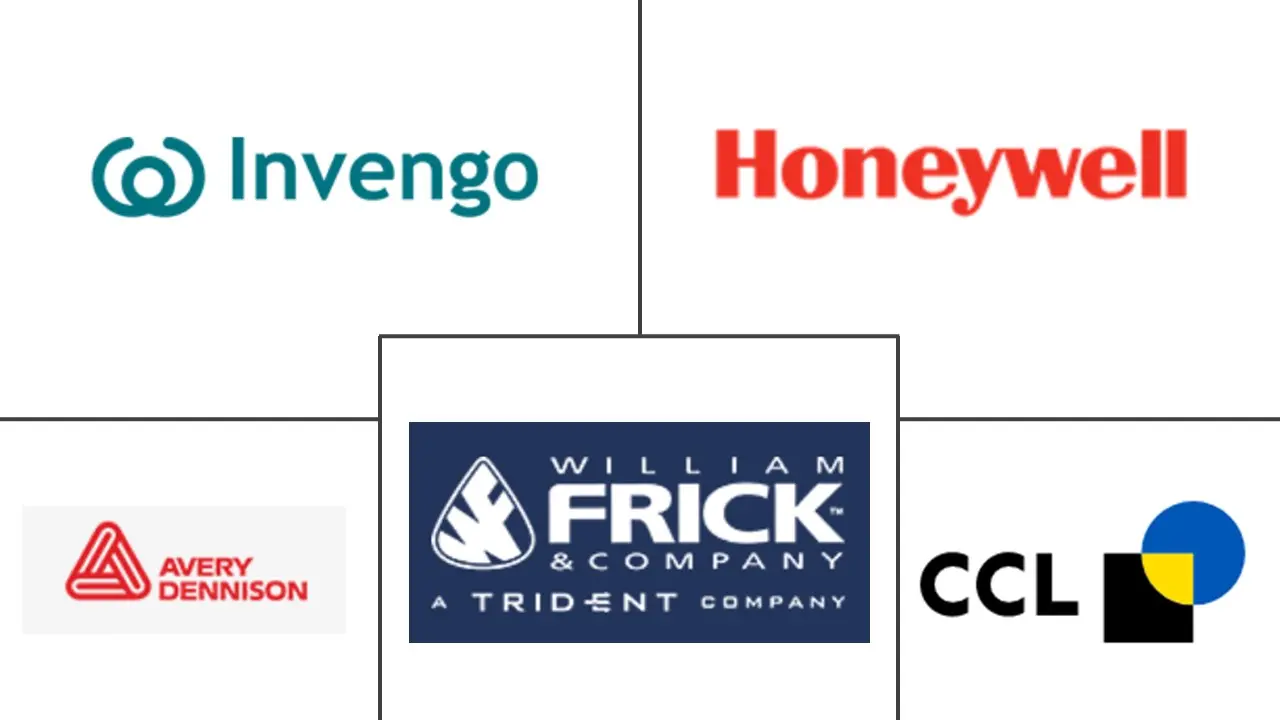Market Size of Smart Label Industry

| Study Period | 2019 - 2029 |
| Market Size (2024) | USD 15.67 Billion |
| Market Size (2029) | USD 33.40 Billion |
| CAGR (2024 - 2029) | 16.34 % |
| Fastest Growing Market | Asia Pacific |
| Largest Market | North America |
Major Players
*Disclaimer: Major Players sorted in no particular order |
Smart Label Market Analysis
The Smart Label Market size is estimated at USD 15.67 billion in 2024, and is expected to reach USD 33.40 billion by 2029, growing at a CAGR of 16.34% during the forecast period (2024-2029).
Smart labels are becoming one of the most popular technologies across the retail, healthcare, and logistics sectors and are viewed as an ideal means to achieve greater efficiencies and profitability while providing the authenticity of an item and its traceability from the warehouse to the distribution center throughout the supply chain.
- The changing consumer behavior and lifestyle have brought a higher interest in safe and traceable food on e-commerce platforms and raised public consciousness of health and safety in general. According to an IBM study, 71% of consumers are ready to pay an additional average premium of 37% for companies providing full transparency and traceability. While the food supply chain is one of the most complex and fragmented supply chains, 70% of firms have "visibility gaps" between the initial supplier and internal clients' systems.
- In April 2023, CCL Industries Inc. announced its acquisition of eAgile Inc., a provider of hardware and software solutions tailored for the healthcare sector. This acquisition also includes eAgile's expertise in RFID inlays integrated into labels and the intellectual property of Alert Systems ApS. The integration of eAgile is expected to bolster CCL Label's Healthcare & Specialty division, enhancing its RFID capabilities across the organization. In addition, Alert Systems ApS, a privately held company based in Denmark, specializes in anti-theft solutions for European retailers, complementing Checkpoint's merchandise availability solutions (MAS) product lines.
- These labels are used as a tool to enable smart supply chains. They play a vital role in the marketing and advertising of consumer products. This can be achieved through the provision of product information, as well as the analysis of consumer buying patterns that can be accessed from the data collected by these labels. Cost-cutting over the supply chain by manufacturers to be closer to the nearest level of efficiency has been a critical factor that has augmented the demand and prompted the proactive adoption of these solutions to gain the first-mover advantage in the individual end-user industry.
- Moreover, increasing customer spending patterns and rapid internet penetration are directly influencing the expansion of e-commerce. Thus, consistent demand for smart labels is likely to be generated by e-commerce for product tracking and tracing. To benefit the most from this scenario, smart label manufacturers are launching advanced label solutions, particularly for the e-commerce sector.
- The ability of a smart label to withstand harsh climatic conditions during shipping and exposure to sunlight plays an important role due to the dissolving nature of solvents used during printing. The labels should have the ability to face tough conditions during shipping, storage, or point-of-use, as many labels are subject to damage when exposed to sunlight, chemicals, and dirty or wet environments.
Smart Label Industry Segmentation
The smart label market defines the revenues generated from technology such as electronic article surveillance (EAS), RFID, sensing labels, NFC, and electronic shelf labels (ESL) that are being used in various end-user industries globally. The study includes qualitative coverage of the most adopted strategies and an analysis of the key base indicators in emerging markets.
The smart label market is segmented by technology (electronic article surveillance [EAS], RFID, sensing labels, NFC, and electronic shelf labels [ESL]), end-user industry (retail, healthcare, pharmaceutical, logistics, and manufacturing), and geography (North America [United States and Canada], Europe [United Kingdom, Germany, France, and Rest of Europe], Asia-Pacific [China, India, Japan, South Korea, and Rest of Asia-Pacific], Latin America, and the Middle East, and Africa). The market sizes and forecasts are provided in terms of value in USD for all the segments.
| By Technology | |
| Electronic Article Surveillance (EAS) | |
| RFID | |
| Sensing Label | |
| NFC | |
| Electronic Shelf Label (ESL) |
| By End-user Industry | |
| Retail | |
| Healthcare and Pharmaceutical | |
| Logistics | |
| Manufacturing | |
| Other End-user Industries |
| By Geography | |||||||
| |||||||
| |||||||
| |||||||
| Latin America | |||||||
| Middle East and Africa |
Smart Label Market Size Summary
The smart label market is experiencing significant growth, driven by its increasing adoption across various sectors such as retail, healthcare, and logistics. These labels are integral to enhancing supply chain efficiency, providing product authenticity, and ensuring traceability from warehouses to distribution centers. The rising consumer demand for transparency and traceability, particularly in the food sector, is propelling the market forward. Companies are leveraging smart labels to bridge visibility gaps in complex supply chains, with a focus on e-commerce platforms where the demand for product tracking and tracing is robust. The market is characterized by rapid technological advancements, with players introducing innovative solutions like RFID and NFC technologies to improve inventory management and customer engagement.
North America, particularly the United States, stands out as a major market for smart labels, fueled by the presence of large retail chains and the need for enhanced inventory control and theft prevention. The region's market growth is further supported by strategic acquisitions and partnerships among key players, aiming to expand their product offerings and maintain a competitive edge. Globally, the market is fragmented, with numerous companies investing in advanced technologies to meet the growing demand for smart labels. The future of the smart label market appears promising, with ongoing innovations and increasing adoption across industries expected to drive substantial market expansion in the coming years.
Smart Label Market Size - Table of Contents
-
1. MARKET INSIGHTS
-
1.1 Market Overview
-
1.2 Industry Attractiveness - Porter's Five Forces Analysis
-
1.2.1 Bargaining Power of Suppliers
-
1.2.2 Bargaining Power of Buyers/Consumers
-
1.2.3 Threat of New Entrants
-
1.2.4 Intensity of Competitive Rivalry
-
1.2.5 Threat of Substitutes
-
-
1.3 Industry Value Chain Analysis
-
1.4 Impact of COVID-19 on the Market
-
-
2. MARKET SEGMENTATION
-
2.1 By Technology
-
2.1.1 Electronic Article Surveillance (EAS)
-
2.1.2 RFID
-
2.1.3 Sensing Label
-
2.1.4 NFC
-
2.1.5 Electronic Shelf Label (ESL)
-
-
2.2 By End-user Industry
-
2.2.1 Retail
-
2.2.2 Healthcare and Pharmaceutical
-
2.2.3 Logistics
-
2.2.4 Manufacturing
-
2.2.5 Other End-user Industries
-
-
2.3 By Geography
-
2.3.1 North America
-
2.3.1.1 United States
-
2.3.1.2 Canada
-
-
2.3.2 Europe
-
2.3.2.1 United Kingdom
-
2.3.2.2 Germany
-
2.3.2.3 France
-
2.3.2.4 Rest of Europe
-
-
2.3.3 Asia-Pacific
-
2.3.3.1 China
-
2.3.3.2 India
-
2.3.3.3 Japan
-
2.3.3.4 South Korea
-
2.3.3.5 Rest of Asia-Pacific
-
-
2.3.4 Latin America
-
2.3.5 Middle East and Africa
-
-
Smart Label Market Size FAQs
How big is the Smart Label Market?
The Smart Label Market size is expected to reach USD 15.67 billion in 2024 and grow at a CAGR of 16.34% to reach USD 33.40 billion by 2029.
What is the current Smart Label Market size?
In 2024, the Smart Label Market size is expected to reach USD 15.67 billion.

